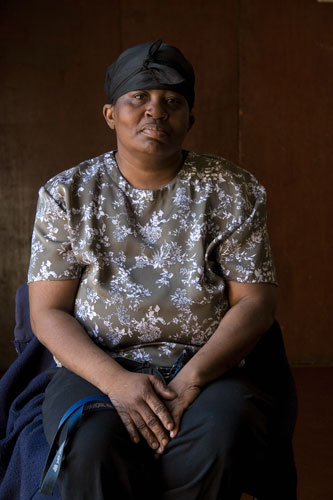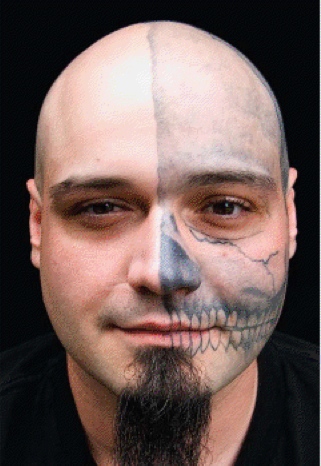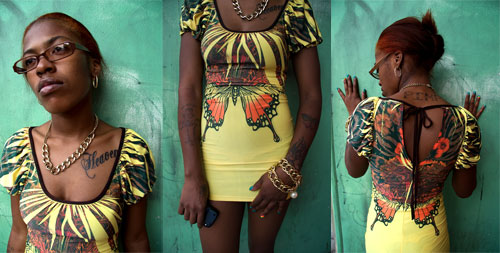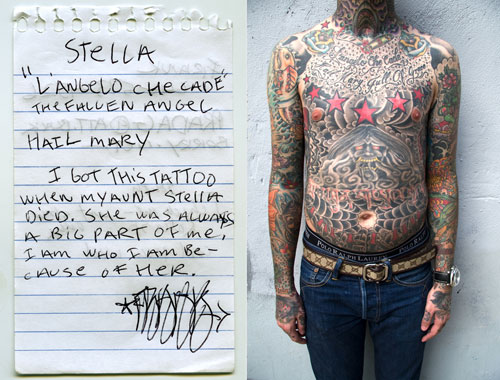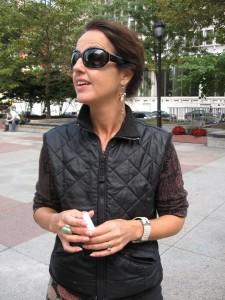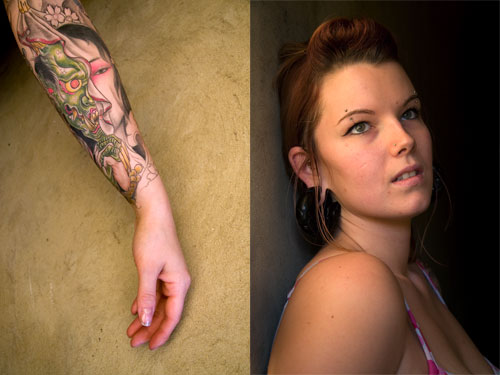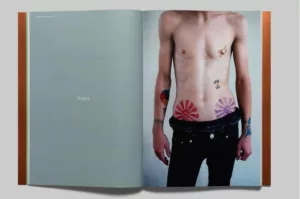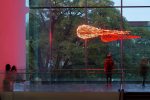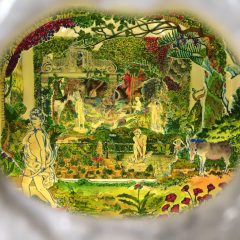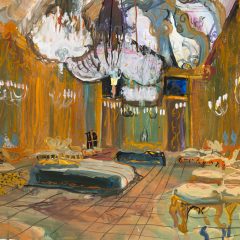Curator and artist Marianne Bernstein last month created the Welcome House in LOVE Park, and tonight she brings you Shelter at the Painted Bride. (The m.o. is similar–invite some terrific artists to work within the constraints of a show while giving them considerable freedom to interpret those constraints.) A book of her photographs, Tatted, is scheduled for release in December. In the Spring, she did a performance for the First Person festival based Tatted. And for Gallery Joe she is curating an exhibit due to open in 2010.
Bernstein, who moved here from New Haven about eight years ago, has finally gotten her Philly sea legs; she’s now moving full steam ahead.
Just a little background first. Bernstein has had a career that has included film and photography in New York and then New Haven. She has worked as a commercial photographer for the Muppets, the Maysles Brothers and more. Esquire and the Atlantic Monthly published her work, and she has received grants from the Honickman and Leeway foundations, and was co-director (with Judy Gelles) and producer for the award-winning documentary “From Philadelphia to the Front.”
I spoke to Bernstein back in July, when Tatted–which documents some of the tattooed people she encountered on South Street–was in the middle of production.
“I’m Interested in people and their stories in whatever form it takes–photos, words, whatever.”
She wanted to photograph people on South Street, near where she lived. But she needed some kind of excuse for approaching people and decided on tattoos.
“I started about two years ago, and even in the last two years, saw a huge rise in the number of people with tattoos.
“When taking a picture, there are two dialectics, the tattoo and the person. There’s a duality. Heaven and hell, all the big themes, Blakian themes, on every person.
“I would walk along South Street and pick a person. All the photos are taken on street level, right there. If you walk along South Street, there’s so much going on, the cars, the signs, the people. I’m a purist. I also have some commercial photography training. It helped because it was hard because of all the cars and crap.
“I couldn’t have done the series anywhere else. There’s a vibe there on the weekend. People aren’t in a hurry. They are open, and they are excited when I ask them.
“I really had to feel centered in order to do this. The interactions took no more than 5 minutes.”
Bernstein said she is pretty much self-taught, but clearly she knows a little of what’s what.
“Portrait of these kinds are not in vogue. They remind me more of some old portrait photographs from the early 1900s.”
I asked, what do the photos remind you of and why. “August Sander. The subjects are in the frame, documented in some way.”
In the forthcoming book of these photos, the pictures are accompanied by notes the subjects wrote in a little book Bernstein carried around with her.
LR: What did you ask people to write in the notes?
MB: I didn’t just want a literal description. I would tell them, this note is going right next to the portrait. What would you like to say? I found ways to be less and less direct about what could go in there. I got better at it.
LR: What kind of equipment do you use?
MB: I used to work in film 4 x 5, Hasselblad. But I switched to digital; I used a Canon 30D.
I didn’t tell them how to pose. I just told them to relax as much as they can, and to look at the camera as if it’s someone you really care about.
Sometimes, it was so intimate. One of the subjects, Bobby Vanity–he’s going to be added to the book–is covered with tattoos. He’s charming. But the tattoos are all about Satan. He wrote in his note that God is Satan. It’s almost as if people can put down their guard more easily with a stranger than with someone they know.
MB: You never know how you’re going to touch people, and they’re going to touch you. The interactions are everything.
LR: Is there anything unique about Philly tattoos?
MB: Philly people use more words. It makes sense since the first printing press was here. In Hawaii, Anna (a local tattoo artist) told me people liked rainbows and fish for their tattoos, but in Philly, people like a lot of words. I made poems from the tattooed words on the people I photographed.
Maybe the tattoos here are so individualistic and artistic because more and more people graduate from art school and need a job, so they become tattoo artists.
LR: How do you pick what’s in the book?
MB: It’s a process of elimination. It’s important what goes next to what. It’ like a poem, an experience looking at them. Doing this is about piercing stereotypes (my own stereotypes, too). Like the Shelter project. I’m trying to go beyond my own comfort zone whenever I can. In the end you find people are pretty much the same.
LR: when you started, were you planning on a book?
MB: I did not go out and try to get a book. I met the designer–I walked into Silica Glass Gallery and saw a nicely designed book. I had been working with Ruth Perlmutter and the Jewish Film Festival, and their design stuff was not so good. So I called him about designing for the Philadelphia Jewish Film Festival. So we became friends. He knew about my tattoo images, because he was with 215 magazine, it’s now only on the internet, which ran some of the photos. Brian founded Grit City Books. Grit was doing a Philly related series of books, all ending in -ed–Smoked, Tatted, Bounced (about Bouncers).
He asked if I was interested in doing a book and if I was still taking photos. I was.
I think it’s funny that all four people working on the project are Jews, and it’s about tattoos.
LR: Why is that funny?
MB: Jews are not comfortable with tattoos–concentration camp numbers were tattooed on people, and also it’s against Jewish law.
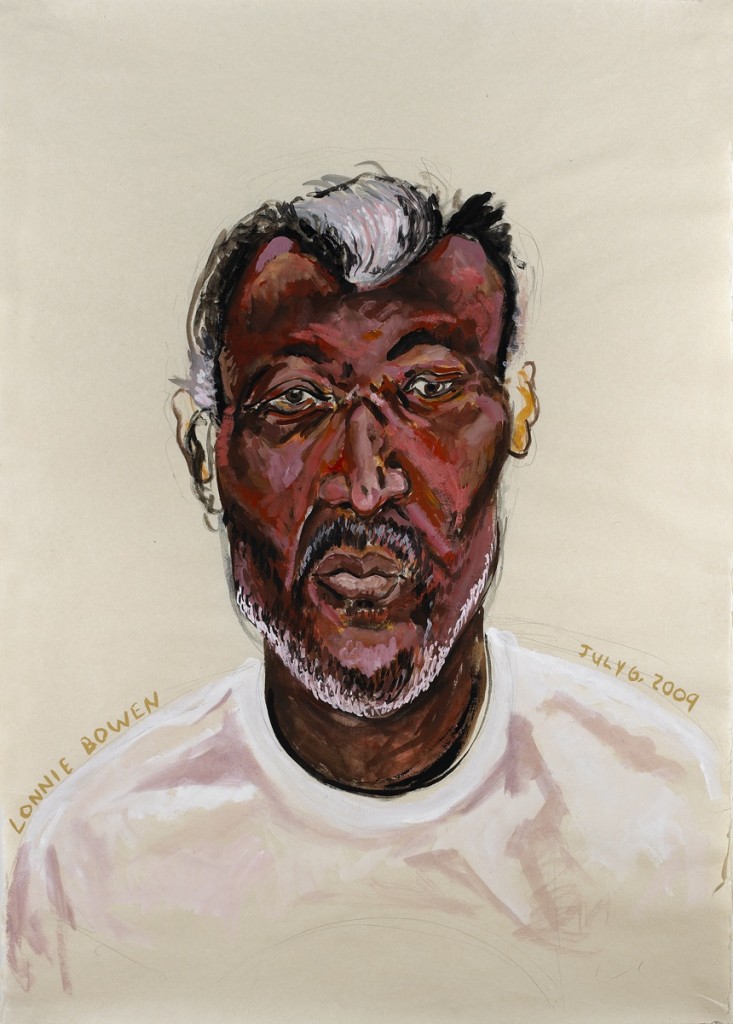
Back to tonight’s show–another venture that brings artists out of their comfort zone, forcing them to confront the private lives of vulnerable people who are having a hard time keeping food on the table and a roof overhead. Shelter features the work of 17 Philadelphia artists–Phillip Adams, Marc Bernstein, Adam Carrigan, Joan Wadleigh Curran, Judy Gelles, John Broderick Heron, Daniel Heyman, David Kessler, Dierdra Krieger, Danielle Lessovitz, Damon Reaves, Ricardo Rivera, Nicholas Santore, Matthew Savitsky, Zoe Strauss, Katie Tachman, and Eva Wylie. They collaborated with 10 Philadelphia households whose homes were restored by volunteers from Rebuilding Together Philadelphia.
The exhibit opens 5-7 p.m.


